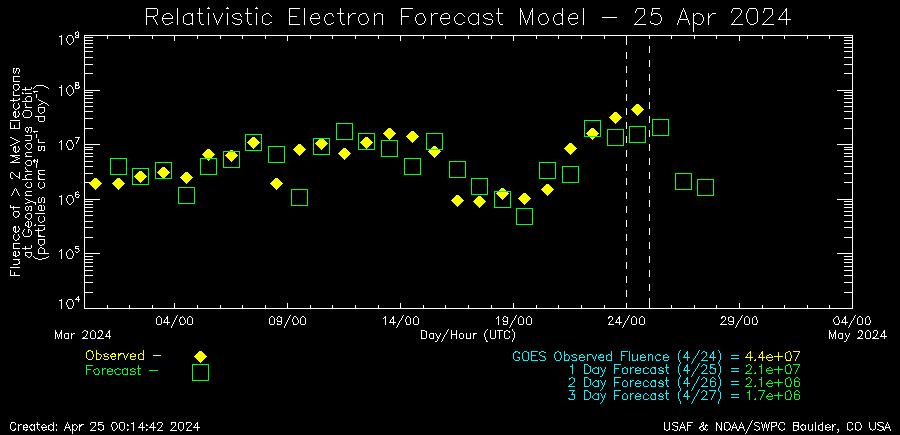The REFM plot displays roughly 30 days of observed and forecast data. Previous forecast values are kept on screen for comparison with observed data. Plot symbols correspond to the 24-hour >2 MeV electron fluence at geo-synchronous orbit, either observed or forecast. The forecasted and observed fluence values for the most recently observed 24-hour period is indicated by the dashed vertical lines. The 1, 2, and 3-day forecasts are to the right of the dashed vertical lines. A legend in the lower left corner indicates the symbol and color-coding used for the observed and forecast values. The lower right corner contains the latest observed and 1-3 day forecast values in a tabular format. The values are also color-coded in the same manner as the plot symbols. The date shown is valid at the beginning of the 24-hour period. When the 72-hour fluence exceeds 109 (cm2 s sr)-1, a warning message is displayed. Red lines (solid for observed and dashed for forecast) appear at the top of the plot, corresponding to the applicable days. A warning message also appears in the legend.
The Relativistic Electron Forecast Model (REFM) predicts the >2 MeV 24-hour electron fluence at geo-synchronous orbit. It is based on a linear prediction filter (Baker, 1990) that uses average solar wind speed as its input. An offset is employed to help account for additional physical processes that can dramatically affect the electron fluence (the fluence can drop 2-3 orders of magnitude in 24 hours without a corresponding change in solar wind speed).
The linear prediction filter is a relatively simple statistical technique in which correlation coefficients are created from historical data by solving a set of linear equations. These coefficients are then applied to real-time data. The REFM uses 30 days of solar wind speed data (currently from the ACE spacecraft) to predict the 24-hour fluence with +1 to +3 days of lead-time.
The electron fluence can exhibit dramatic day-to-day variability, typically associated with strong shocks and/or geomagnetic storming. This is believed to be due to both magnetic field stretching, in which the electron population is temporarily shifted into or out of geosynchronous orbit, and sudden electron loss to either the magnetopause or upper atmosphere. The basic linear filter is unable to account for these processes; given high solar wind speeds it will forecast high electron fluences, even if the electrons actually experience a sudden decrease or increase.
To help account for this short-term variability as well as longer-term drifts, REFM adjusts the output of the basic linear prediction filter with a flux offset. REFM compares previous forecasts to the observed values, computes an offset, and applies it as a correction to the current forecast. The number of days used to compute the offset varies; for example, the +1 Day forecast uses only the most recent forecast/observed pair, while the +2 and +3 forecasts all use the past 20 days of forecast/observed pairs. These numbers were chosen to maximize the performance statistics of each mode.
Although the offset improves the statistics, at best the flux offset's response lags a day behind the environment's variability. This causes an associated rise in model errors during solar maximum when coronal mass ejections (CMEs) and subsequent strong geomagnetic storms are prevalent. For this reason, the REFM performs best during solar minimum.
Both the electron sensor on GOES and the SWEPAM sensor on ACE are subject to contamination during proton events. To avoid this contamination, the REFM will not use these data when the >30 MeV protons exceed 50 (cm2 s sr)-1 (a fairly conservative threshold). Without solar wind speed data for the current day, the REFM will not produce a forecast. An outage in ACE coverage or a satellite maneuver can also cause a data gap resulting in no forecast.
Reference:
Baker, D.N., et al, "Linear Prediction Filter Analysis of Relativistic Electron Properties at 6.6 Re", J. Geophysical Res., 95, A9, 1990.
The REFM model was developed by Colonel Chris Smithro (USAF). It has been well established that high-energy (relativistic) electrons can cause deep dielectric charging of satellites, which can in turn lead to spacecraft upsets and/or complete satellite failures [Reagan et al, 1983; Baker et al, 1987]. These relativistic electrons are monitored at geo-synchronous orbit by GOES satellite instruments; plots of the data are available on SWPC’s web page. To warn customers of possible damaging effects, SWPC issues alerts when the >2 MeV electron flux at GOES exceeds 103 particle flux units (pfu) (cm2 s sr)-1 for more than three consecutive five-minute periods. An even more significant threshold is when the cumulative fluence exceeds 109 pfu over a 72-hour period.
REFM forecasts were created to supplement current SWPC alerts by providing guidance as to the future likelihood of damaging relativistic electron events. Since the REFM output is a daily fluence forecast, not flux, it applies most directly to the high fluence threshold. In fact the graphical model output displays a warning message during periods when the 72-hour fluence exceeds or is forecast to exceed 109 pfu. High 24-hour fluence values can also be used as a proxy for high flux levels. A study of data measured between 1995 and 2000 showed that when the 24-hour fluence exceeds 3 × 107 pfu the SWPC flux alert criteria is nearly always met (false alarm ratio = 0.07, miss frequency = 0.06). With this threshold, REFM fluence forecasts can be used to predict SWPC flux alerts.
References:
Baker, D.N., et al, "Deep Dielectric Charging Effects Due to High Energy Electrons in the Earth’s Outer Magnetosphere", J. Electrost., 20, 3, 1987.
Reagan, J.B., et al, "Space Charging Currents and their Effects on Spacecraft Systems", IEEE Trans. Electr. Insul., EI-18, 345, 1983.
Model predictions and performance statistics in ASCII text format are available:
Historical electron particle data is archived at the National Geophysical Data Center.
